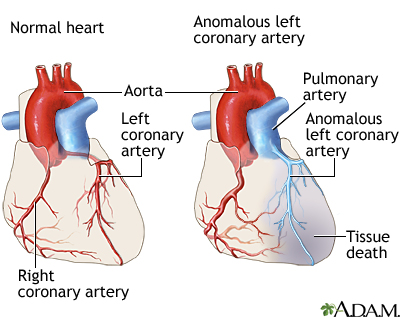Health Topics
Anomalous left coronary artery from the pulmonary artery (ALCAPA) is a heart defect. The left coronary artery (LCA), which carries blood to the heart muscle, begins from the pulmonary artery instead of the aorta.
ALCAPA is present at birth (congenital).
Causes
ALCAPA is a problem that occurs when the baby's heart is developing early in the pregnancy. The developing blood vessel does not attach correctly to the heart muscle.
In the normal heart, the LCA originates from the aorta. It supplies oxygen-rich blood to the heart muscle on the left side of the heart as well as the mitral valve (the heart valve between the upper and lower chambers of the heart on the left side). The aorta is the major blood vessel that takes oxygen-rich blood from the heart to the rest of the body.
In children with ALCAPA, the LCA originates from the pulmonary artery. The pulmonary artery is the major blood vessel that takes oxygen-poor blood from the heart to the lungs to pick up oxygen.

When ALCAPA occurs, blood that is lacking in oxygen is carried to the heart muscle on the left side of the heart. Therefore, the heart muscle does not get enough oxygen. The tissue begins to die due to lack of oxygen. This can cause a heart attack in a baby.
A condition known as coronary steal further damages the heart in babies with ALCAPA. The low blood pressure in the pulmonary artery causes blood from the abnormally connected LCA to flow back toward the pulmonary artery instead of toward the heart muscle. This results in less blood and oxygen to the heart muscle. This problem can also lead to a heart attack in a baby. Coronary steal develops over time in babies with ALCAPA if the condition is not treated early.
Symptoms
Symptoms of ALCAPA in an infant include:
- Crying or sweating during feeding
- Irritability
- Pale skin
- Poor feeding
- Rapid breathing
- Symptoms of pain or distress in the baby (often mistaken for colic)
Symptoms can appear within the first 2 months of the baby's life.
Exams and Tests
Typically, ALCAPA is diagnosed during infancy. In rare cases, this defect is not diagnosed until someone is a child or adult.
During an exam, your health care provider will likely find signs of ALCAPA, including:
- Abnormal heart rhythm
- Enlarged heart
- Heart murmur (rare)
- Rapid pulse
Tests that may be ordered include:
- Echocardiogram, which is an ultrasound that views the heart structures and blood flow inside the heart
- Electrocardiogram (ECG), which measures the electrical activity of the heart
- Chest x-ray, which produces an image of the heart and large arteries
- MRI, which provides a detailed image of the heart
- Cardiac catheterization, a procedure in which a thin tube (catheter) is placed into the heart to see blood flow and take accurate measurements of blood pressure and oxygen levels
Treatment
Surgery is needed to correct ALCAPA. Only one surgery is needed in most cases. However, the surgery will depend on the baby's condition and the size of the involved blood vessels.
If the heart muscle supporting the mitral valve is seriously damaged from decreased oxygen, the baby may also need surgery to repair or replace the valve. The mitral valve controls blood flow between the chambers on the left side of the heart.
A heart transplant can be done in case the baby's heart is severely damaged due to lack of oxygen.
Medicines used include:
- Water pills (diuretics)
- Medicines that make the heart muscle pump harder (inotropic agents)
- Medicines that lower the workload on the heart (beta-blockers, ACE inhibitors)
Outlook (Prognosis)
Without treatment, most babies do not survive their first year. Children who do survive without treatment may have serious heart problems. Babies with this problem who aren't treated could die suddenly during the following years.
With early treatment such as surgery, most babies do well and can expect a normal life. Routine follow-ups with a heart specialist (cardiologist) will be needed.
Possible Complications
Complications of ALCAPA include:
- Heart attack
- Heart failure
- Heart rhythm problems
- Permanent damage to the heart
When to Contact a Medical Professional
Contact your provider if your baby:
- Is breathing rapidly
- Looks very pale
- Seems distressed and cries often
Alternative Names
Anomalous origin of the left coronary artery arising from the pulmonary artery; ALCAPA; ALCAPA syndrome; Bland-White-Garland syndrome; Congenital heart defect - ALCAPA; Birth defect - ALCAPA
References
Brothers JA, Gaynor JW. Surgery for congenital anomalies of the coronary arteries. In: Sellke FW, del Nido PJ, Swanson SJ, eds. Sabiston and Spencer Surgery of the Chest. 10th ed. Philadelphia, PA: Elsevier; 2024:chap 129.
Gaudino M, Di Franco A, Arbustini E, et al. Management of adults with anomalous aortic origin of the coronary arteries: State-of-the-Art Review. J Am Coll Cardiol. 2023;82(21):2034-2053. PMID: 37855757 pubmed.ncbi.nlm.nih.gov/37855757/.
Johnson JT, Harris M, Anderson RH, et al. Congenital coronary anomalies. In: Wernovsky G, Anderson RH, Kumar K, et al, eds. Anderson's Pediatric Cardiology. 4th ed. Philadelphia, PA: Elsevier; 2020:chap 46.
Kliegman RM, St. Geme JW, Blum NJ, et al. Other congenital heart and vascular malformations. In: Kliegman RM, St. Geme JW, Blum NJ, et al, eds. Nelson Textbook of Pediatrics. 22nd ed. Philadelphia, PA: Elsevier; 2025:chap 481.
Review Date 5/27/2024
Updated by: Michael A. Chen, MD, PhD, Associate Professor of Medicine, Division of Cardiology, Harborview Medical Center, University of Washington Medical School, Seattle, WA. Also reviewed by David C. Dugdale, MD, Medical Director, Brenda Conaway, Editorial Director, and the A.D.A.M. Editorial team.




